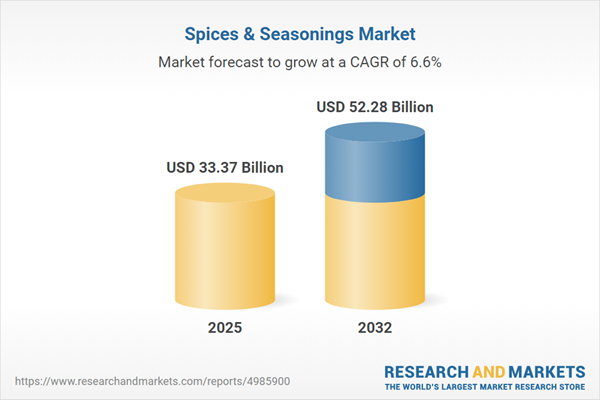Speak directly to the analyst to clarify any post sales queries you may have.
The global spices and seasonings market is transforming as executives drive digitalization, sustainability, and transparency across supply chains. Leading companies prioritize responsible sourcing, operational efficiency, and risk mitigation to remain competitive amid increasingly complex sector dynamics.
Market Snapshot: Spices and Seasonings Market Outlook
In 2024, the spices and seasonings market achieved a valuation of USD 31.27 billion, underpinned by a compound annual growth rate (CAGR) of 6.63%. Widespread adoption of clean-label ingredients, combined with digital logistics integration, is strengthening business models. As operational agility becomes critical, enterprises are more effectively addressing supply chain disruptions and ongoing market shifts. Innovation in product offerings and an increased focus on regulatory compliance further reinforce market resilience, while ongoing digital technology investments are supporting long-term adaptability and stability in the sector.
Scope & Segmentation in the Spices and Seasonings Market
- Form: Powder, flake, liquid, paste, and whole options enable manufacturers to shift production and address demand volatility, seasonal trends, and varied application needs.
- Nature: Conventional and organic product variants provide flexibility for adapting to consumer expectations. Organic alternatives are becoming more relevant as firms respond to sustainability mandates and prioritize health-focused innovation.
- Product Type: Single-ingredient spices and blended seasonings, including types such as curry or barbecue, equip B2B players to serve distinct consumer tastes and expand reach across culinary categories and regions.
- Application: Use spans foodservice, at-home cooking, and industrial processing, requiring bespoke packaging, distribution, and marketing to meet expectations for product quality and traceability.
- Distribution Channel: Multi-channel approaches—encompassing supermarkets, specialty retailers, e-commerce platforms, direct ordering, and subscription services—extend customer access and improve delivery strategies.
- Geography: Distinct regional considerations shape deployment in the Americas, Europe, Middle East, Africa, and Asia-Pacific, including adherence to regulatory standards, sourcing dependability, and adaptation to diverse consumer behaviors for increased global competitiveness.
- Key Companies: McCormick & Company, Archer-Daniels-Midland, Olam International, Unilever, Kerry Group, Givaudan, International Flavors & Fragrances, Sensient Technologies, The Kraft Heinz Company, and B&G Foods influence industry benchmarks with active research efforts, commitment to ethical sourcing, and the implementation of technology-driven logistics solutions.
Key Takeaways for Senior Decision-Makers
- Strategic focus on new product development enables organizations to anticipate changing culinary trends and secure a stronger market position.
- Prioritizing clean-label and organic solutions strengthens traceability, supports brand alignment with health and sustainability values, and simplifies compliance with evolving regulations.
- Adoption of digital tools, including analytics and blockchain, enhances supply chain transparency and enables swift response to operational disruptions.
- Commitment to sustainable practices—such as eco-conscious packaging and responsible sourcing—facilitates compliance and future-proofs organizational operations against shifting global requirements.
- Broadening product portfolios and evolving distribution strategies, bolstered by targeted digital transformation initiatives, allow businesses to proactively meet dynamic customer requirements and sector expectations.
Tariff Impact and Global Trade Adjustments
Shifts in United States tariff policy have prompted market participants to revise sourcing frameworks and build closer supplier collaborations. These changes highlight the ongoing need for agile risk management strategies. Enhanced cooperation with supply partners safeguards operational continuity, supports regulatory compliance, and strengthens responsiveness to fluctuating global trade conditions.
Methodology & Data Sources
This market analysis draws on comprehensive secondary research, structured stakeholder interviews, and advanced analytics. All insights have been independently validated to ensure accuracy and reliability, enabling informed strategic planning and robust risk assessment.
Why This Report Matters
- Equips leaders with actionable segmentation insights, unlocking new growth opportunities while addressing emerging sector risks.
- Offers guidance on key regulatory trends and supply chain digitization, informing operational strategy and supporting innovative product development initiatives.
- Delivers objective, current market analytics to guide supplier selection and investment decisions, designed for executive-level relevance.
Conclusion
Ongoing leadership in the spices and seasonings sector requires a commitment to digital transformation, sustainability, and strategic agility. By advancing these priorities, senior executives ensure their organizations remain adaptive and well-prepared for evolving market realities.
Additional Product Information:
- Purchase of this report includes 1 year online access with quarterly updates.
- This report can be updated on request. Please contact our Customer Experience team using the Ask a Question widget on our website.
Table of Contents
3. Executive Summary
4. Market Overview
7. Cumulative Impact of Artificial Intelligence 2025
Companies Mentioned
The companies profiled in this Spices & Seasonings market report include:- McCormick & Company, Incorporated
- Archer-Daniels-Midland Company
- Olam International Limited
- Unilever PLC
- Kerry Group plc
- Givaudan SA
- International Flavors & Fragrances Inc.
- Sensient Technologies Corporation
- The Kraft Heinz Company
- B&G Foods, Inc.
Table Information
| Report Attribute | Details |
|---|---|
| No. of Pages | 197 |
| Published | October 2025 |
| Forecast Period | 2025 - 2032 |
| Estimated Market Value ( USD | $ 33.37 Billion |
| Forecasted Market Value ( USD | $ 52.28 Billion |
| Compound Annual Growth Rate | 6.6% |
| Regions Covered | Global |
| No. of Companies Mentioned | 11 |









